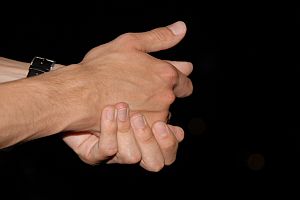The Secret Weapons that Can Keep You Flexible and Young
 Everyone develops scar tissue over time. This is the body’s normal reaction to injury—no matter how slight.
Everyone develops scar tissue over time. This is the body’s normal reaction to injury—no matter how slight.
But scar tissue can keep you stiff and increasingly inflexible. Because of it many people can’t do the activities they used to enjoy like play tennis or garden.
Even simple actions that most people wouldn’t regard as injury-producing can lead to a buildup of scar tissue. Repetitive motions like typing, for example, can cause micro-trauma to the soft tissue (often referred to as an overuse injury), leading to carpal tunnel syndrome. As part of the repair process, scar tissue is created.
Scar tissue is important for you to understand because it tends to interfere with the smooth movement of muscle and may eventually affect your range of motion or how well you move your hands, turn your head to see the car in your blind spot or bend your body to stretch your muscles effectively. The effects of scar tissue doesn’t have to progress to the point where it’s uncomfortable to you if it’s nipped in the bud at the right time.
If you have ever felt a tightness or inability to move a joint in a fluid manner, you likely have a buildup of scar tissue. Our soft tissues (including tendons and ligaments) are made of collagen, which is a substance that looks like strands of rope wound together into a net-like formation called fascia. When an injury occurs, it causes frays, kinks and bends in the collagen strands of the fascia, which create the scar tissue. Ideally, scar tissue is replaced by normal tissue as it heals, but this does not always happen.
Adhesions are small bits of scar tissue that bind the tissues around them, leading to stiffness and a reduction in strength and range of motion. Nerves often become trapped in these adhesions, creating “trigger points” from which pain can radiate. Painful movements lead to less activity, and less activity leads to a further reduced range of motion. Because scar tissue has less circulation and is less flexible and elastic than normal muscle tissue, muscles become shorter and weaker. It is important to remove these scar tissue adhesions in order to reduce pain and restore strength and the proper range of motion.
The secret weapons to relieve built up scar tissue so you stay flexible and young:
Hands-on therapies such as the Active Release Technique (ART), Graston Technique and Myofascial Release are used by some chiropractors as a way of breaking up scar tissue to release trapped nerves and restore greater range of motion.
Hands-on therapies are the only way to get true relief of the body’s scar tissues. The Graston Technique uses stainless steel instruments to break up the fascia, whereas ART and Myofascial Release employ a direct hands-on approach to remove adhesions and break up scar tissue.
Many chiropractors incorporate one or both of the above therapies into their practice to help increase their patient’s strength and range of movement, as well as helping their chiropractic adjustments to last longer.
You can become more flexible and pain-free, even if you’ve already started feeling the effects of scar tissue build up. And the best thing about getting hands-on therapy by a chiropractor is, the more fluid and free of scar tissue your muscles and joints are, the less likely tense muscles will pull the spine or other joints back out of alignment. We offer hands-on, pain-free, chiropractic care that is the most effective method of eliminating scar tissue and other stiffness in your muscles and joints. Receive a complimentary “Pain Relief and Flexibility” consultation by contacting us today.